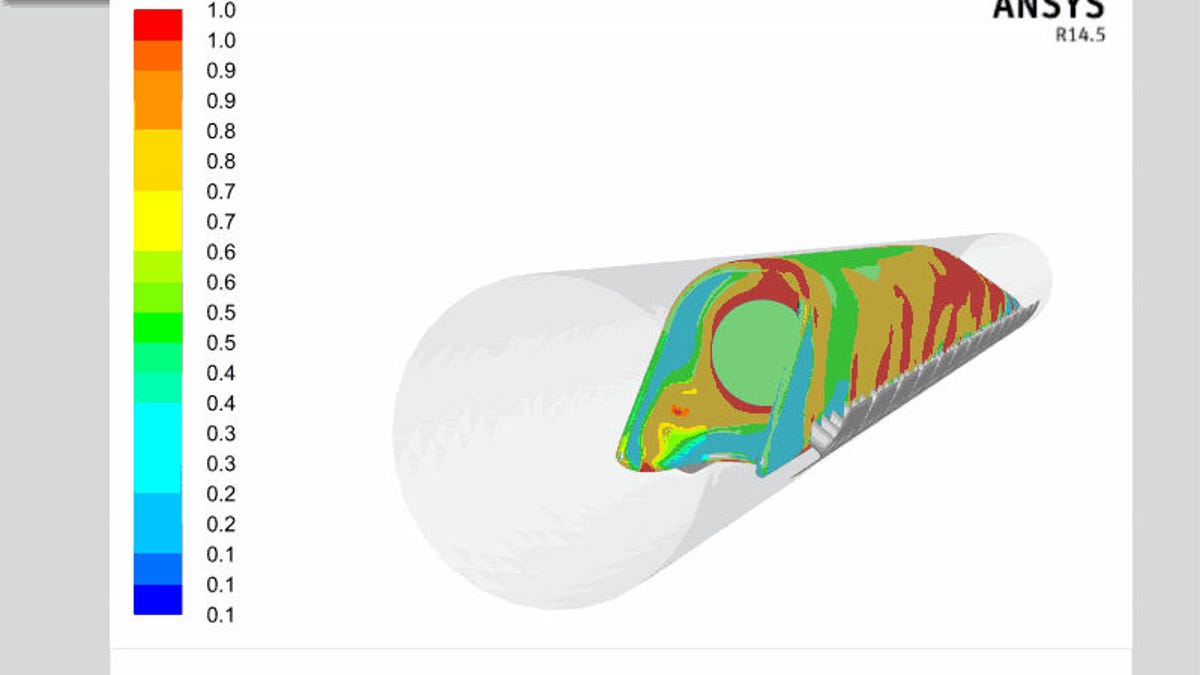Simulation verdict: Elon Musk's Hyperloop needs tweaking
Ansys, a company specializing in computer-based engineering simulations, inches the moon-shot idea one step closer to reality.

The Hyperloop is currently pigeon-holed as one of two extremes: as a futuristic, sci-fi fascination or a realistically impossible waste of time. Even the progenitor of the electromagnetic-powered tube transport, Elon Musk of SpaceX and Tesla, admits that a working prototype on a much smaller scale than the proposed San Francisco to Los Angeles model is required to take the idea out of its proof-of-concept stage.
That's what computer-based engineering simulation company Ansys -- who Musk employs for SpaceX simulations -- is trying to do by tackling the Hyperloop concept virtually. The early simulations show that the design as it stands now -- first laid out by Musk's 58-page "alpha" design -- still needs massive tweaking to become a safe and viable mode of transport.
Musk conceded that his theorized designs, which were drawn up with help from colleagues at both Tesla and SpaceX, need to be vigorously crowdsourced for improvement. Ansys hopes to be a large player in that process, and it joins a growing crowd of enthusiasts -- Redditors included -- from all over the Web who want to see the vision become a reality through crowdsourcing and even crowdfunding.
Computer simulations are now commonplace tools in product design and engineering. Ansys, which works with 96 of the top 100 industrial companies in the Fortune 500, has been hired to create engineering simulations for everything from fighter jets and consumer automobiles to skyscrapers and Olympic swimwear. It was even hired by Emirates Team New Zealand to help simulate the massive sailboat it would go on to use to win the Louis Vuitton Cup this past summer.
The company uses its proprietary software platform, Workbench, and a number of tools to accomplish this. For instance, its Fluent software simulates things like flow, turbulence, and heat transfer, while its HFSS software creates 3D simulations of electromagnetic fields for electronic component.
Fluent was the simulation software Ansys used to test out the Hyperloop's issues with air flow, energy efficiency, and potential environmental damage with regard to near-supersonic travel.
"The first thing to look into this sort of a vehicle is to look at if the flow is going to become supersonic anywhere," explained Sandeep Sovani, the director of land transportation strategy at Ansys who believes systems like the Hyperloop could be a reality within the next decade or two. The issue with the current design of the Hyperloop, as taken from Musk's initial outline, is that the vehicle is designed to go Mach 0.99, or just before the speed of sound so as to avoid sonic booms. Sonic booms create the potential for environmental destruction as well as produce immense noise disruption.
"The air coming in from one end of the pipe has to be moved past the vehicle. So think of it as the air has to be pushed to go through a narrow gap, and if it's pushed it has to go at a higher speed," Sovani said. In other words, even if the Hyperloop isn't supersonic, the air around it can be.
"If the flow of the vehicle becomes supersonic, it leads to a different class of engineering problems that become very challenging," he added. To operate the vehicle at subsonic speeds and yet keep the air flow from breaking the sound barrier, "the shape of the vehicle has to be very, very carefully prepared."
Air flow problems like this are what contribute to the large patches of red in the first simulation slide, seen here on the left. The red indicates that the stress -- not the kind of stress that would destroy the vehicle but rather the force pulling the vehicle backward -- is too great near the right side and back of the vehicle to make it energy efficient.
Sovani said the idea is to minimize the red areas as much as possible by creating a uniformly aerodynamic body that is much more symmetric, like a bullet or missile rocket.
"If you look at an aircraft, the flow structure is smooth. There is not much difference between the Hyerloop and a supersonic aircraft," he said.
As for whether or not the complexity of the Hyperloop concept outpaces current simulation technology, Sovani explained that the design's similarity to supersonic aircrafts puts it in line with the capability of current software.
"All of the tools needed are all there in simulation tech today," he said. "I think simulation will very much influence the first physical prototype because this is how the development of aircrafts and cars are typically done."
The first step to bringing the Hyperloop to life was the hand-drawn sketch the public received in Musk's proof-of-concept. The next step, which Ansys has stepped in to provide, is virtual prototypes simulated to test engineering faults.
"At that time of an actual physical prototype, all of the homework essentially is done. A lot of decisions about the design are already made before the physical prototype is made," he added, explaining that physical prototyping is hugely time consuming and expensive and so great effort is put into making sure it's a viable test.
While the company has succeeded in pointing out only early stage flaws in the Hyperloop design, Ansys wants to continue to be a part of the crowdsourced project while keeping its community aspect alive and well. It plans on releasing its first few rounds of simulation data and insights on its company blog by the end of this week. Sovani also said that Ansys is open to collaborating on other forums and platforms.
"We want to make this information very freely available to anyone who wants it," he said. "Part of it is intellectual curiosity...But also I think tube transportation is the next leap forward."

